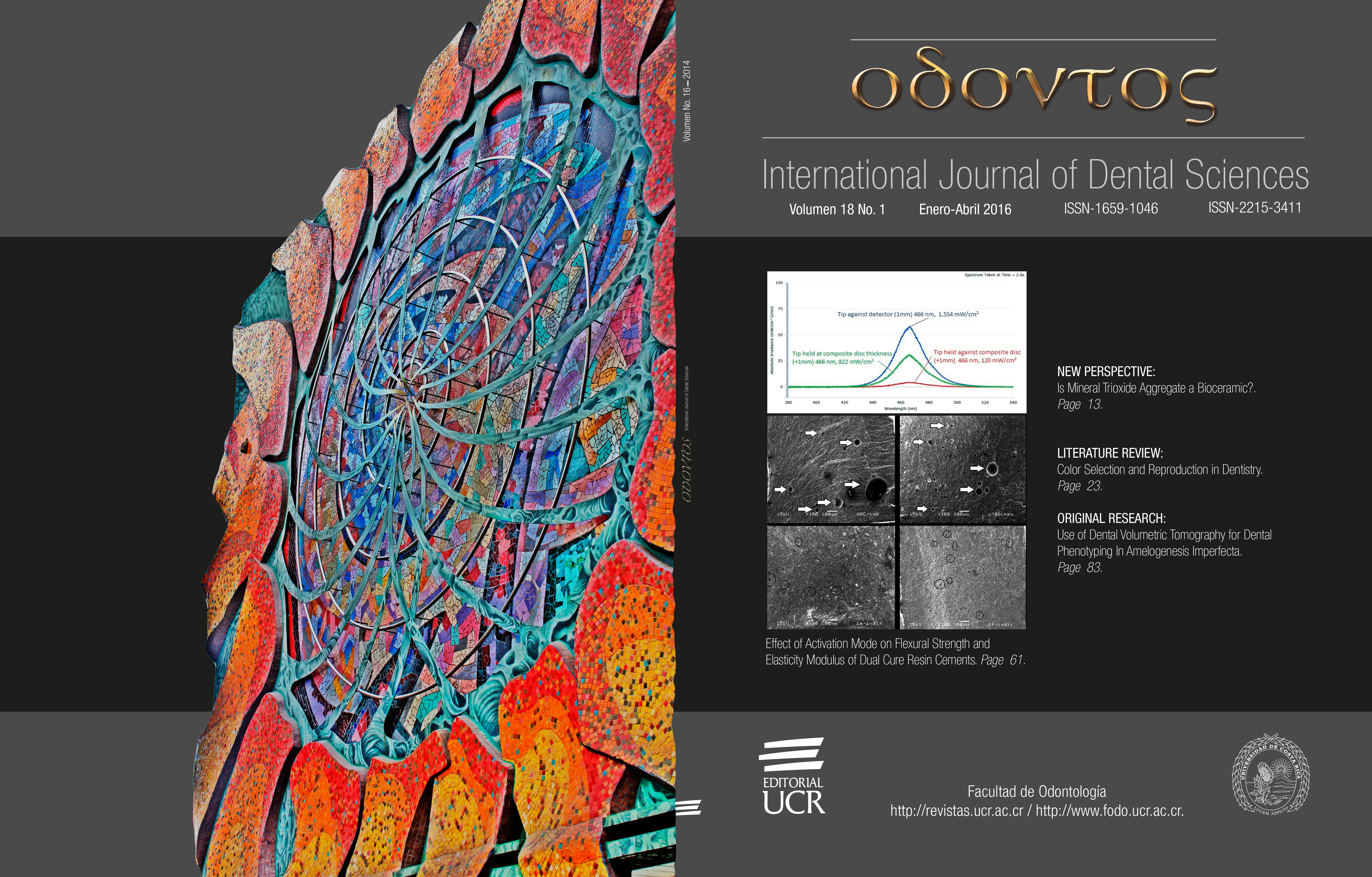Abstract
Literature showed that the interaction of Mineral Trioxide Aggregate (MTA) with dentin in phosphate-buffered saline (PBS) promotes a biomineralization process that leads to the formation of an interfacial layer with mineralized structures at the cement-dentin interface. Thus, we investigated the in vivo biomineralization process promoted by MTA and Ca(OH)² with dentin. Human dentin tubes filled with ProRoot MTA, Ca(OH)² or kept empty were implanted in subcutaneous tissues in the back of mice. After 12h, 1, 3, 7, 15, 30 and 60 days, the dentin tubes were processed for Scanning Electron Microscope (SEM) observations. SEM examination showed the presence of apatite-like clusters on collagen fibrils over the surface of tubes containing the biomaterials. This mineral deposition was more extensive and compact through time. At day 7, a compact layer of apatite was formed. The MTA/Ca(OH)² -dentin interface showed intratubular mineralization as early as 12h post-implantation. MTA and Ca(OH)² in an in vivo environment promoted a biomineralization process with dentin, simultaneously to the acute inflammatory response. MTA triggered an earlier and denser interfacial layer.
References
Thomson P. L., Grover L. M., Lumley P. J., Sloan A., Smith A. J., Cooper P. R. Dissolution of bio-active dentine matrix components by mineral trioxide aggregate. J Dent 2007; 35: 636-42.
Ferracane, J. L., Cooper, P. R., Smith, A. J. Can interaction of materials with the dentin-pulp complex contribute to dentin regeneration? Odontology 2010; 98: 2-14.
Tay F. R., Pashley D. H., Rueggeberg F. A., Loushine R. J., Weller R. N. Calcium phosphate phase transformation produced by the interaction of the Portland cement component of white mineral trioxide aggregate with a phosphate-containing fluid. J Endod 2007; 33:1347–51.
Reyes Carmona J., Felippe M. S., Felippe W.T. Biomineralization ability and interaction of Mineral Trioxide Aggregate and white Portland cement with dentin in a phosphate-containing fluid. J. Endod 2009; 35:731-6.
Reyes-Carmona J. F., Felippe M. C. S., Felippe W. T. The biomineralization ability of Mineral Trioxide Aggregate and Portland cement on dentin enhances the push-out strenght. J Endod 2010; 36: 286– 291.
Reyes-Carmona J. F. et al. Host–Mineral Trioxide Aggregate Inflammatory Molecular Signaling and Biomineralization Ability. J Endod 2010; 36:1347–1353.
Holland R., de Souza V., Nery M. J., Otoboni Filho J. A., Bernabe P. F., Dezan J. E. Reaction of rat connective tissue to implanted dentin tubes filled with mineral trioxide aggregate or CH. J Endod 1999; 25:161–6.
Faraco I. M., Holland R. Response of the pulp of dogs to capping with mineral trioxide aggregate or a calcium hydroxide cement. Dental Traumatology 2001;17:163–6.
Dominguez M.S., Witherspoon D.E., Gutmann J. L., Opperman L. A. Histological and scanning electron microscopy assessment of various vital pulp-therapy materials. J Endod 2003; 29: 324–33.
Tay F.R., Pashley D.H. Guided tissue remineralisation of partially demineralized human dentine. Biomaterials 2008; 29: 1127-37.
Huang, T. H. et al. Inflammatory cytokines reaction elicited by root-end filling materials. J Biomed Mater Res B Appl Biomater 2005; 73:123-8.
E.T. et al. Cellular response to Mineral Trioxide Aggregate. J Endod 1998; 24: 543-7.
Minamikawa, H. et al. Effect of Mineral Trioxide Aggregate on rat clonal dental pulp cells: expression of cyclooxygenase-2 mRNA and inflammation-related protein via nuclear factor kappa B signaling system. J Endod. 2009; 35: 843-6.
Chen, C. L., T. H. Huang, S. J. Ding, M. Y. Shie and C. T. Kao. Comparison of calcium and silicate cement and mineral trioxide aggregate biologic effects and bone markers expression in MG63 cells. J Endod 2009; 35: 682-5.
Hakki, S. S., S. B. Bozkurt, E. E. Hakki and S. Belli. Effects of mineral trioxide aggregate on cell survival, gene expression associated with mineralized tissues, and biomineralization of cementoblasts. J Endod 2009; 35: 513-9.
Holland R. et al. Calcium salts deposition in Rat connective tissue alter the implantation of CH-containing sealers. J Endod 2002; 28: 173-6.
Bohner M., Lemaitre J. Can bioactivity be tested in vitro with SBF solution? Biomaterials 2009; 30: 2175-9.
Sarkar N. K., Caicedo R., Ritwik P., Moiseyena R, Kawashima I. Physiochemical basis of the biologic properties of mineral trioxide aggregate. J Endod 2005;31:97–100.
Bozeman T.B., Lemon R.R., Eleazer P.D. Elemental analysis of crystal precipitate from gray and white MTA. J Endod 2006; 32: 425–8.
LeGeros R.Z. Calcium phosphates in oral biology and medicine. In: Myers HM, ed. Monographs in oral science 15. Basel, Switzerland: Karger; 1991: 4–66.
Veis A. Mineral– matrix interactions in bone and dentin. J Bone Miner Res 1993;8(Suppl. 2): S493–7.
Graham L., Cooper P. R., Cassidy N., Nor J.E., Sloan A.J., Smith A.J. The effect of CH on solubilisation of bioactive dentine matrix components. Biomaterials 2006; 27: 2865–73.

